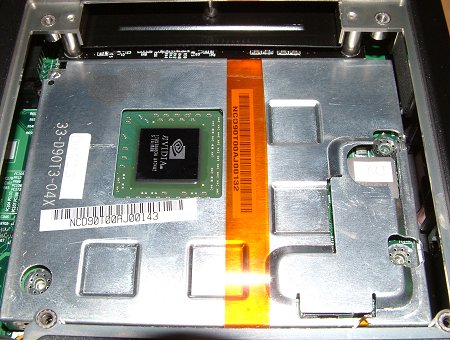GeForce 6800 Go 256MB
GeForce 6800 Go 256MBAlthough it's an integral part of the Ixius 3.6 laptop, I'm discussing the GeForce 6800 Go 256MB card in more detail separately.
As of yesterday, NVIDIA's mobile graphics processors were derived from its desktop GeForce FX range of GPUs. Leading the pack was GeForce FX Go 5700 which was released just under a year ago. Offering vital statistics of a 4-pipe rendering setup, 128-bit memory interface, and core/memory frequencies of around 350MHz/600MHz, respectively, it was a robust solution that offered adequate competition to ATI's Mobility Radeon 9600 and, to an extent, MR9700 parts. Time has moved on and ATI has successfully launched its MR9800 mobile GPU, derived from its leading R420 part and featuring 8 pixels pipelines and a 256-bit memory bus. Just those specs are enough to give ATI a definite performance edge.
NVIDIA's response was kind of predictable, to say the least. It's NV40 parts, sporting new features such as Shader Model 3.0 and massive parallel rendering power, have done well in the premium sector. It's no wonder, then, that any all-new mobile part would be architected from what makes NV40 tick. The GeForce 6800 Go, codenamed NV41M, is a scaled-down version of the desktop NV40. Rather than list each individual change from GeForce FX Go 5700, I'll let a table do the talking.
| Card | GeForce 6800 Go | ATI Mobility Radeon 9800 | GeForce FX Go 5700 |
| Manufacturing process | 130nm | 130nm | 130nm |
| Interface | PCI-Express (X16) | AGP 8x | AGP 8x |
| Shader Model | 3.0 | 2.0 | 2.0 |
| Render setup | 12x1 | 8x1 | 4x1 |
| Onboard memory | 256MB | 256MB | 128MB |
| Core speed | 275MHz* | 350MHz | 350MHz |
| Single-texture fillrate | 3300MPixel/s | 2800MPixel/s | 1400MPixel/s |
| Texture units | 1 | 1 | 1 |
| Multi-texture fillrate | 3300MTexels/s | 2800MTexels/s | 1400MTexels/s |
| Memory type | DDR2 | DDR1 | DDR1 |
| Memory speed | 600MHz* | 550MHz | 600MHz |
| Memory bus width | 256-bit | 256-bit | 128-bit |
| Memory bandwidth | 19.2GB/s | 19.2GB/s | 9.6GB/s |
MV's Ixius 3.6 ships with a GeForce 6800 256MB card clocked in at 275MHz core and 600MHz memory. The desktop GeForce 6800's 12-rendering pipelines have been kept intact and offer the most parallelism of any mobile part. That's why, even with a comparatively lowly-clocked core , fillrate is still impressive. NVIDIA reckons the core architecture is good for 450MHz core and 1.2GHz DDR3 memory. It's not all just about pure grunt, however. Just like desktop part, the GeForce Go 6800 complies with Microsoft's Shader Model 3.0 specification for both Pixel and Vertex shaders. SM 3.0, amongst other things, offers much longer shader lengths in comparison to SM 2.0 and also 32-bit precision, resulting in some lovely-looking effects. You'll know what I mean if you've seen the recent Far Cry (patch 1.3) screenshots with NVIDIA's High Dynamic-Range applied. Other GeForce 6-series technologies such as CineFx 3.0, UltraShadow II, and IntelliSample 3.0 are also present. Image enhancement stays at NVIDIA's 6000-series standard of 8x Rotated Grid AntiAliasing and 16x Anisotropic Filtering.
Another first for NVIDIA comes way of the 6800 Go's 256MB onboard memory. Recent gaming textures have become large enough to seriously affect performance of cards with 128MB video memory when either high resolutions and/or AntiAliasing/Anisotropic Filtering is applied. Take DOOM 3 as an example. It runs poorly in High Quality mode with 128MB-equipped cards. The '6800 Go's 256MB will come in handy for upcoming games. A first for any mobile GPU, though, is a native PCI-Express interface, necessary due to the use of an Intel Grantsdale motherboard.
Believe it or not, up until now there's not been a unified form factor for mobile GPUs. ODMs have been sold the GPU and then designed an appropriate interface for a particular chassis. It's reduced wait times but has inevitably led to limited upgradeability for end-users and unwanted hassle for ODMs when designing interfaces for differing notebooks. You'd think there would be an accepted industry standard such as AGP or PCI-Express, wouldn't you?. NVIDIA's attempting to right this wrong by pushing its MXM (Mobile PCI-Express Module) that's featured on the GeForce 6800 Go. MXM purports to be a single industry-accepted, consistent interface that can be used in any notebook with the minimum of design and fuss. Future upgradeability would then be a simple matter of slotting in a new mobile GPU for a present one.
There's little doubt after a perusal of the specification table above that GeForce 6800 Go is a potent gaming performer. NVIDIA has also added in the NV40's non-3D qualities too. PureVideo is a case in point. The second-generation implementation in the GeForce 6800 Go provides for both MPEG2 and WMV hardware-assisted acceleration (when implemented via a working driver!), as well as a host of other nifty technologies. GeForce 6800 Go is primed for NVIDIA's Scalable Link Interface (SLI). I wonder how long it will be before we see it in notebook form?.

GeForce 6800 Go 256MB in all its glory. Note that Clevo is still using its proprietory format until MXM becomes widespread. The interface is on the left-hand side. MV/Clevo use another heatpipe-equipped cooler to good effect. Enough talk, I reckon, let's see how it benchmarks.









